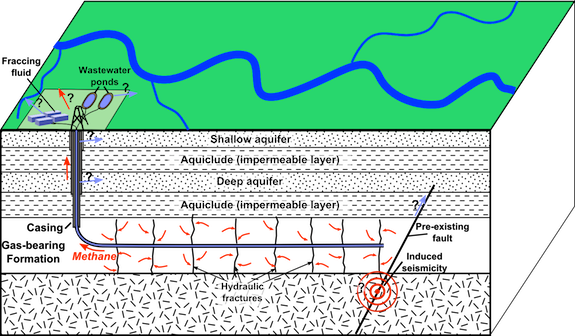‘Fracking’ for Natural Gas Is Linked With Earthquakes
A new study finds a correlation between the underground injection of waste fluids from fracking and dozens of small earthquakes
/https://tf-cmsv2-smithsonianmag-media.s3.amazonaws.com/filer/Fracking-natgas-hero-681.jpg)
Hydraulic fracturing (a.k.a. “fracking”) recovery techniques for oil and natural gas are a controversial business. The practice—in which a mix of water, sand and chemicals is injected deep into bedrock at high pressure to create fractures, allowing gas and oil to flow upward—was developed in the late 1990s and has become more and more common across the United States over the past few years, opening up geologic areas such as the Bakken Shale in North Dakota and the Marcellus Shale in Pennsylvania, New York and West Virginia to dramatic increases in gas production.
On the one hand, proponents argue that hydraulic fracturing increases the amount of energy that can be economically produced in the United States, making oil and gas cheaper and reducing our dependency on foreign imports. Opponents, though, note that fracking causes dangerous chemicals to leach into groundwater, releases known carcinogens into the air and increases our contribution to climate change.
Alongside these observed problems, though, a different sort of worry has emerged: the idea that hydraulic fracturing can trigger an earthquake. Scientists have known for decades that injecting fluids into the earth could cause quakes, but we were uncertain just how much of an increase widespread fracking might cause. This past spring, USGS scientists decided that the recent dramatic increase in the number of small quakes in the United States is “almost certainly manmade,” but were unable to conclusively tie it to this particular activity.
Now, the evidence is starting to pile up. A study published today in the Proceedings of the National Academy of Sciences finds a correlation between dozens of small earthquakes in Texas’ Barnett Shale region—the site of intensive hydraulic fracturing activity—and the locations of injection wells used to dispose of the wastes of this process. ”You can’t prove that any one earthquake was caused by an injection well,” says Cliff Frohlich, the University of Texas geologist who conducted the study, “but it’s obvious that wells are enhancing the probability that earthquakes will occur.”
To come to the finding, Frohlich analyzed two years’ worth of data from a network of extremely sensitive seismographs that was installed in the region in 2009. He discovered dozens of small earthquakes that had not been previously reported—and found that all 24 of the quakes for which he was able to establish an accurate epicenter occurred within two miles of an injection well.
One important distinction is that these wells were the disposal sites for waste fluids that had already used to fracture rock, rather than the original wells used to extract the gas. Although the actual gas extraction wells cause many microearthquakes by their very nature (they literally crack the bedrock to release gas and oil), these are far too small to be felt by humans or cause any damage. The fluid disposal wells, though, are more likely to cause earthquakes of significance, because they are sites of injection for a longer duration over time.

The waste fluids may trigger earthquakes by acting as lubricants in pre-existing faults deep underground, allowing masses of rock to slide past each other more easily and relieve built-up pressure. All of the wells that Frohlich found correlated with quakes were home to high rates of injection (more than 150,000 barrels of fluid per month). However, there were other wells in the area with similar rates of injection that did not correlate with increased seismic activity. ”It might be that an injection can only trigger an earthquake if injected fluids reach and relieve friction on a nearby fault that is already ready to slip,” explains Frohlich.
The good news is that all of these earthquakes were still relatively small, with magnitudes of less than 3.0 on the Richter scale, unlikely to cause any damage on the surface. Seismologists, though, are concerned that fluid injection could cause larger quakes if the fluid migrates into older, deeper rock formations beyond the local shale, which are home to larger fault lines. A number of earthquakes that occurred in Ohio last year, including one with a 4.0 magnitude, were linked to disposal of fracking fluids.
Frohlich notes that much more research is needed to help us understand exactly why some wells are more likely to cause earthquakes than others. For those already concerned about fracking, though, his new research adds another major concern to a growing list.
/https://tf-cmsv2-smithsonianmag-media.s3.amazonaws.com/accounts/headshot/joseph-stromberg-240.jpg)
/https://tf-cmsv2-smithsonianmag-media.s3.amazonaws.com/accounts/headshot/joseph-stromberg-240.jpg)